I Hate My Nose After Rhinoplasty: What to Do?
If you’re having some regrets after your rhinoplasty, keep in mind final results won’t present themselves right away. You’re not going to be able to see the true aesthetic results of your rhinoplasty until it’s fully healed, which will take up to a year or longer.
But what about when you’ve healed from your original procedure, and you still regret your rhinoplasty? Let’s dive into some of the reasons why this might happen, and what you can do about it – especially if you can get to Manhattan, New York or New Orleans, Louisiana for revision rhinoplasty.
Is it normal to not like your nose after rhinoplasty?
If you’ve been watching your rhinoplasty heal over time and you’re still thinking “I don’t like my nose”, it’s not unheard of. As many as 10-15% of cosmetic nose surgeries result in unhappy clients who will choose to undergo a second procedure to fix it. This commonly occurs for a few reasons:
- You may have trusted an inexperienced surgeon with inferior talent, resulting in lackluster nose surgery results. Rhinoplasty is one of the most complex of all facial plastic surgeries, requiring a great deal of precision, skill, and artistry to perform correctly. This is one reason why so many rhinoplasty procedures result in revisions.
- A lack of communication between you and your doctor may have led to bad rhinoplasty results. Many failed nose jobs stem from the doctor thinking that their patient was looking for something that they didn’t express.
- Complications can present themselves during the procedure or healing process that can lead to a bad rhinoplasty result overall.
- Even in the best of hands and the most simple of procedures, rhinoplasty is not an entirely predictable operation as there are many factors after the surgery that play a role in forming the final result that you and your surgeon have no control over.
When does your nose stop changing after a nose job?
There are a variety of rhinoplasty changes that occur over time during your healing process. That’s part of why it’s strongly encouraged to hold off on a revision rhinoplasty until you can see the full results after 12-18 months of healing. Until that time, the final form or function of the nose won’t be apparent.
Swelling and unactualized results may make your nose seem too big, too short, look the same as it did before, look fat, or feel weird after rhinoplasty. This can lead to post-rhinoplasty depression – but if you let yourself heal, you will find you have options to improve your results.
What Do I Do If I’m Unhappy with My Rhinoplasty?
After you’ve given your nose adequate time to heal, what happens if you’re still unhappy with the results? First, let’s go through the types of issues that commonly manifest as undesirable results, or a nose job fail.
Pinched Tip
This happens when too much cartilage is removed from the tip of the nose, leading to less than ideal aesthetic results. This can also reduce functionality, leading to breathing troubles. Over time, a lack of support to the tip will result in a collapse of the shape of the nostrils.
Here’s a correction of a nasal tip through a revision rhinoplasty performed by Dr. Miller:
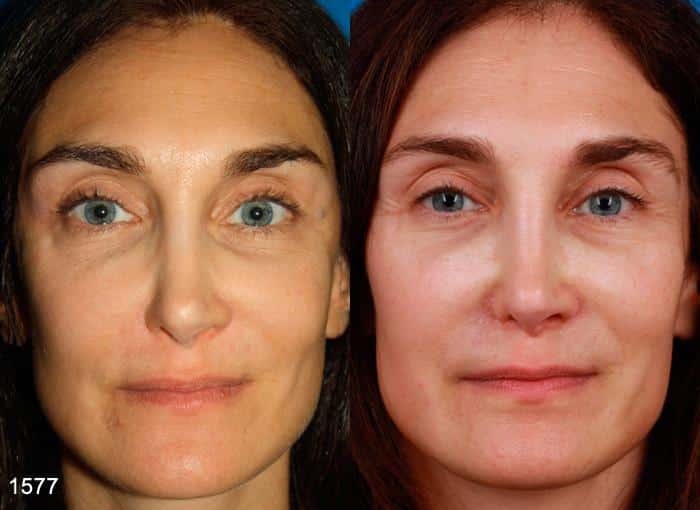
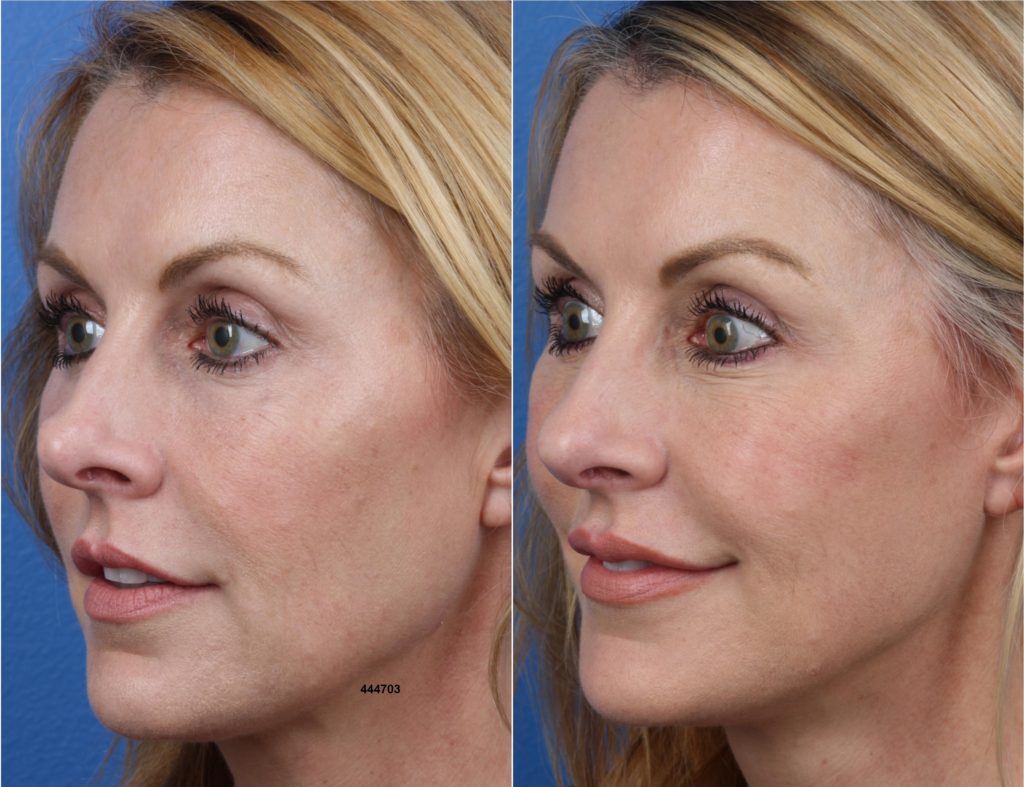
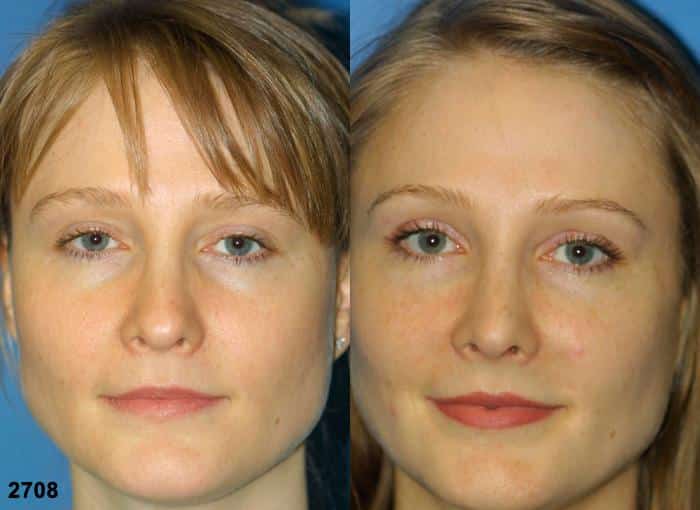
Short Nose
If too much cartilage is removed during the initial rhinoplasty, the appearance of a “short nose” may result. Through the use of specialized grafts and reinstating cartilage, a more natural-looking shape can be returned to the nose with a revision rhinoplasty.
Here’s an example of some of Dr. Miller’s work in this area:
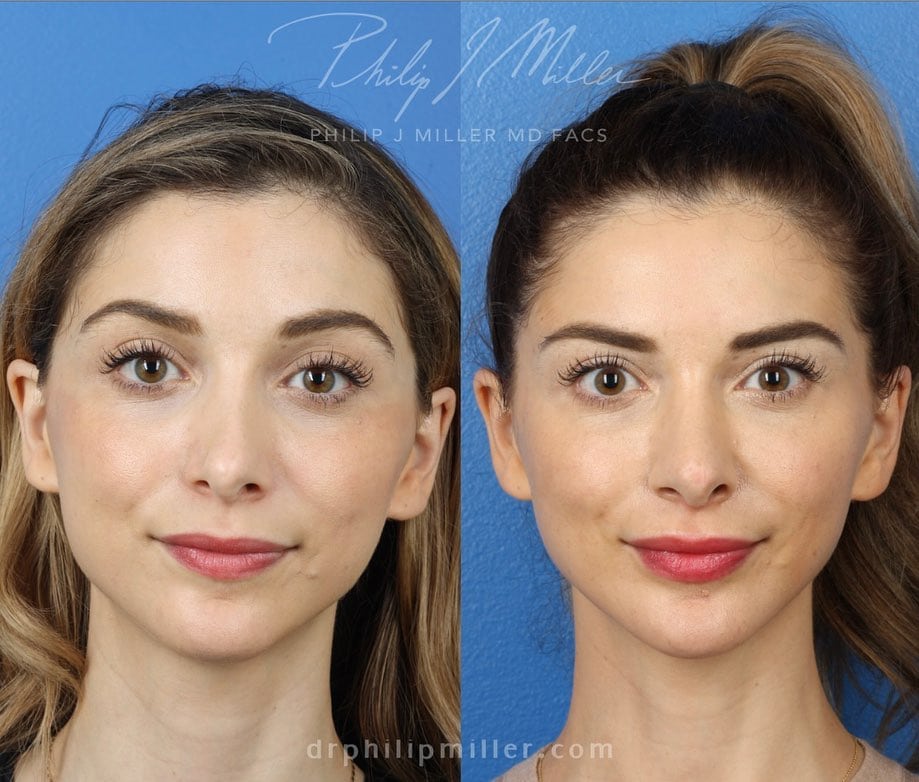
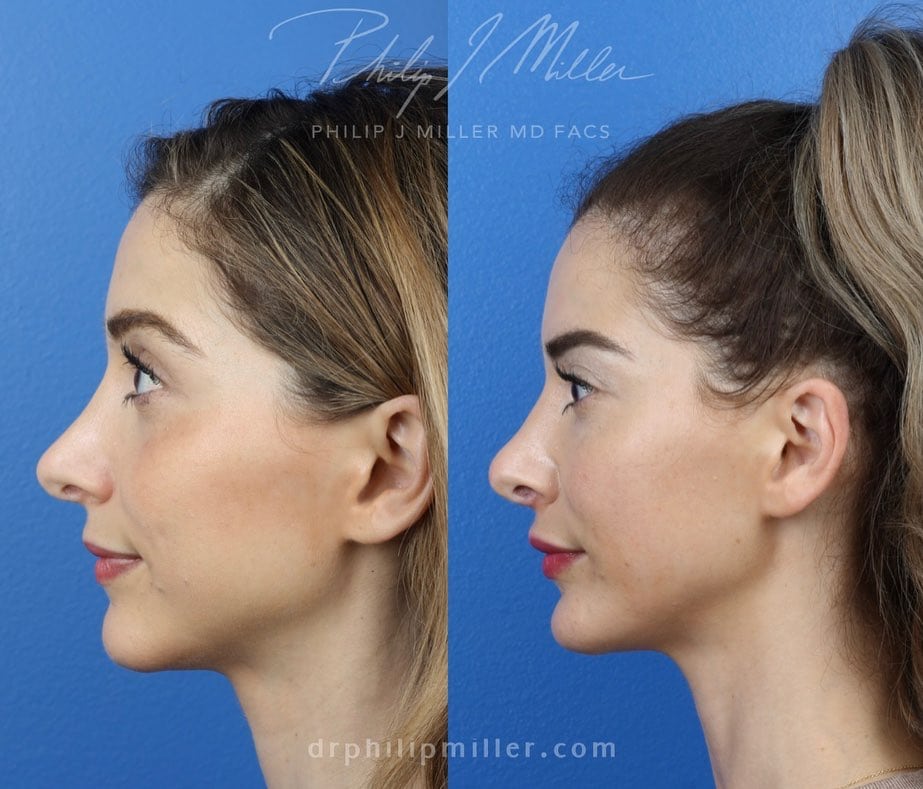
Crooked/Twisted Bridge
A “crooked” or “twisted” appearance can occur as a result of nasal trauma. This can be corrected by making the nose symmetrical again by rearranging the cartilage and the bone.
Here are some examples of Dr. Miller’s work that focus on symmetry:
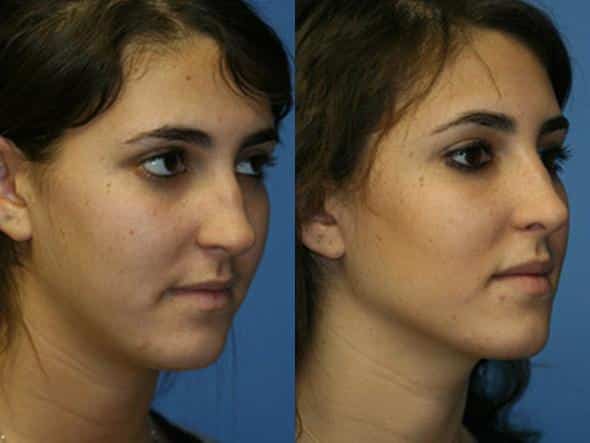
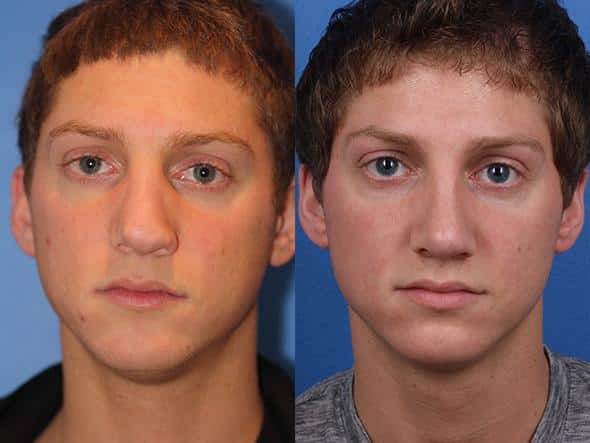
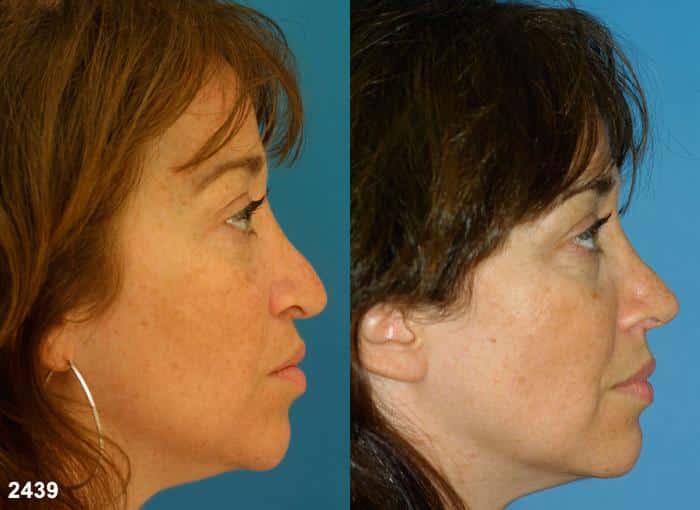
How to tell your plastic surgeon you are unhappy?
After going through the emotionally and physically exhaustive process of planning and completing your initial rhinoplasty, it can seem daunting to consider going through those steps again. After experiencing a bad nose surgery, you wouldn’t want to spend that time and money again for another rhinoplasty fail. However, the first logical step is to address your concerns with the surgeon who performed your initial surgery.
If your original surgeon cannot provide you with a satisfactory response to your issues, you may need to look for another surgeon to perform revision rhinoplasty for you. The most important factor here is the plastic surgeon you choose.
A board-certified facial plastic surgeon is often the best choice for a revision rhinoplasty procedure. These specialists have intimate knowledge of the nose, studying first as an ear, nose, and throat specialist. The addition of plastic surgery training ensures these surgeons have both the expertise and the artistry to enhance the appearance of the nose while preserving function.
How Can I Fix My Rhinoplasty?
Philip J. Miller, MD, FACS, is a board-certified facial plastic surgeon who specializes in procedures for the nose and face. He offers his proprietary NatraLook® Process, which is a patient-centric approach to understanding your needs, listening to your expectations, and going through every step with communication and trust. With a technique that combines artistry and science, Dr. Miller has performed over 5,000 successful surgeries.
You need a surgeon with proven abilities, who has achieved a high success rate in producing the most natural-looking and aesthetically-pleasing rhinoplasty results in Manhattan, New York, and New Orleans, Louisiana. Schedule your consultation with Dr. Miller today by calling 646-791-3025, or booking online.
Learn how rhinoplasty can make a nose appear smaller here.
Surgical or Liquid (Non-Surgical) Rhinoplasty: Which one is right for me?
When it comes to getting a nose job, there are two basic options: surgical or non-surgical. Surgical rhinoplasty requires anesthesia, incisions, and downtime, but produces permanent improvement. A non-surgical rhinoplasty, commonly known as a liquid rhinoplasty, is a less invasive option that utilizes injectable fillers to temporarily change the appearance of the nose.
When considering a rhinoplasty, it is essential to realize that different types of rhinoplasty procedures are used, depending on the severity of alterations. Individualizing a rhinoplasty procedure ensures that results are natural and balanced to your unique facial features.
What is liquid rhinoplasty?
Liquid rhinoplasty is a non-surgical alternative to a surgical rhinoplasty procedure that uses injectable dermal fillers to make the nose more appealing. This less invasive option may produce pleasing results with a quicker approach and less recovery time.
Juvederm® and Restylane® are two common dermal fillers used for liquid rhinoplasty. Juvederm is an FDA-approved volume enhancer containing hyaluronic acid, a naturally occurring substance in the body. Restylane is another hyaluronic acid injectable that restores and rejuvenates the skin. These fillers can add hydration and volume to the nose and alter the shape for a more appealing appearance.
Even though liquid rhinoplasty is not a surgical procedure, it still requires skill and experience to inject the filler into the correct area for intended results. The process is quick and patients can return to normal daily activities after the injection. It is an effective alternative with many benefits, including:
- Non-invasive
- Minimal downtime
- Safe and effective
- Instant results
- Smoother nose shape
- More balanced appearance
What’s the difference between liquid and regular rhinoplasty?
Surgical and liquid rhinoplasty are two very different procedures with different processes, results, recovery, costs, and expectations. Take a look at the breakdown:
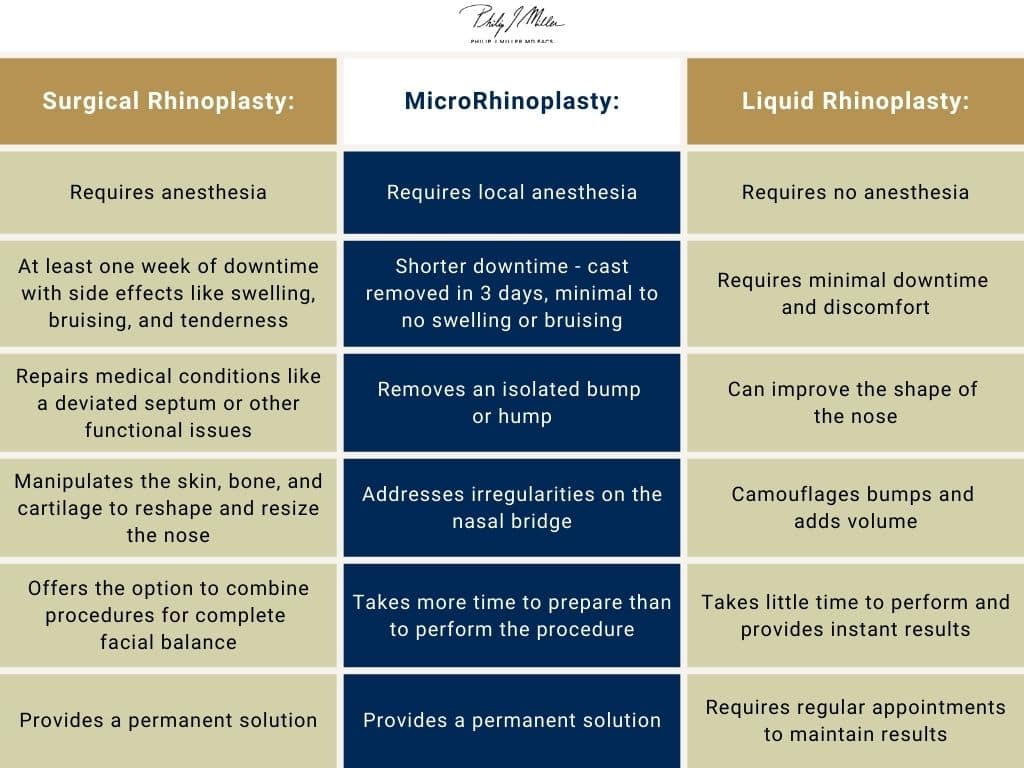
Surgical Rhinoplasty:
- Requires anesthesia
- Manipulates the skin, bone, and cartilage to reshape and resize the nose
- Repairs medical conditions like a deviated septum or other functional issues
- Requires downtime of at least one week before returning to work and daily activities
- Is associated with side effects like swelling, bruising, and tenderness
- Provides a permanent solution
- Offers the option to combine procedures for complete facial balance
Liquid Rhinoplasty:
- Is minimally invasive
- Requires minimal downtime and discomfort
- Can improve the shape of the nose
- Camouflages bumps and adds volume
- Takes little time to perform
- Provides instant results
- Is associated with minimal swelling, bruising, and tenderness
- Requires regular appointments to maintain results
How much does liquid rhinoplasty cost in NYC?
The cost of rhinoplasty procedures varies by patient and depends on the treatment plan. Non-surgical rhinoplasty costs typically range from $300-$1300 per treatment. Some of the factors that impact price include:
- Type of dermal fillers used
- Number and amount of filler injected
- Experience and expertise of injector
It is also important to understand that liquid rhinoplasty is not a permanent solution and requires regular appointments to maintain the desired shape. Patients can learn more about the specific costs of liquid rhinoplasty during a consultation with Dr. Miller.
@drphilipjmiller #liquidrhinoplasty ! In 10 minutes, no down time, you will have a new nose that last about 2 years. Call today and book a session with me! #nonsurgicalrhinoplasty ♬ original sound – Sam Smith
How much does surgical rhinoplasty cost in NYC?
Surgical rhinoplasty encompasses a wide range of possible alterations and additional steps, such as a graft or implant. Due to the variance in procedure possibilities, there is also a wide range of costs. An average surgical rhinoplasty procedure in New York City ranges from $3,500-$25,000. During a consultation, Dr. Miller will explain the treatment plan and expected costs.
How long does liquid rhinoplasty last?
Unlike a surgical rhinoplasty, liquid rhinoplasty is not a permanent solution. This treatment requires regular appointments to maintain your pleasing results. Results vary by patient depending on how many dermal fillers were used, where they were injected, and the level of correction required. Many patients see results for around 18 months before needing a touch-up session. Dr. Miller and his expert team will evaluate your nose and treatment plan for a suggested maintenance schedule to keep a natural and well-balanced nose shape.
How long does surgical rhinoplasty last?
Surgical rhinoplasty is a permanent procedure that has lifelong results. Once the nose is reshaped and altered, it will remain in its new state with proper care.
Which one is better: surgical or non-surgical rhinoplasty?
Both procedures are practical and effective solutions, depending on the patient’s specific needs and desires. Philip Miller, MD, FACS, strives to help patients achieve aesthetic confidence and natural results using the NatraLook® process. During your consultation, Dr. Miller discusses your concerns and expectations to identify which procedure is right for you and create a unified treatment plan.
Dr. Miller is a double board-certified surgeon in facial plastic and reconstructive surgery and head and neck surgery. He is a world-class surgeon and leading expert in rhinoplasty and facial rejuvenation. With more than 20 years of expertise, Dr. Miller works closely with patients to identify their needs and desires to create unmatched results.
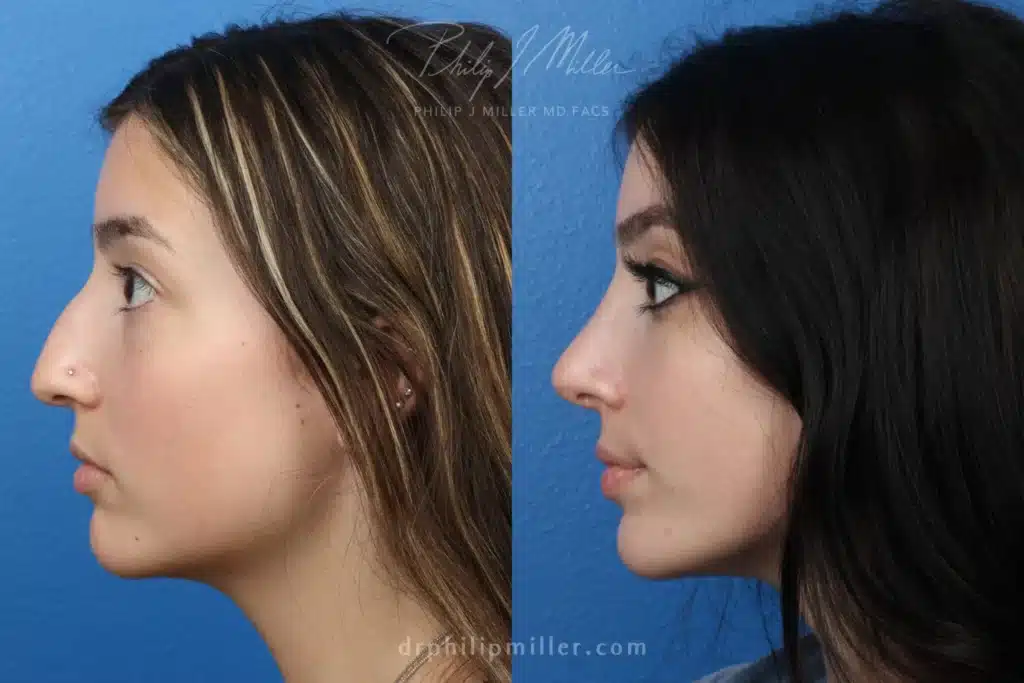
Contact us to schedule a consultation and learn more about which rhinoplasty procedure is right for you.
Nose Taping After Rhinoplasty
Nose taping is a common practice among rhinoplasty patients. It is a bandage or tape used during rhinoplasty recovery to support the nose, decrease swelling, and improve the nose’s appearance. Philip Miller, MD, FACS, often recommends nose taping to enhance a patient’s healing process after nose surgery, provided it’s done correctly.
What are the benefits of nose taping after rhinoplasty?
Nose taping after rhinoplasty is beneficial for many reasons. The primary benefit is that it helps to decrease swelling fluctuations after the procedure. It also helps improve:
- Bruising
- Bleeding
- Breathing
- Healing process
- Final appearance
Some patients choose to tape their noses daily or multiple times per day to help them feel better. However, it is most commonly recommended at night when swelling is most likely to occur. It is not necessary to tape during the day unless specified by Dr. Miller.
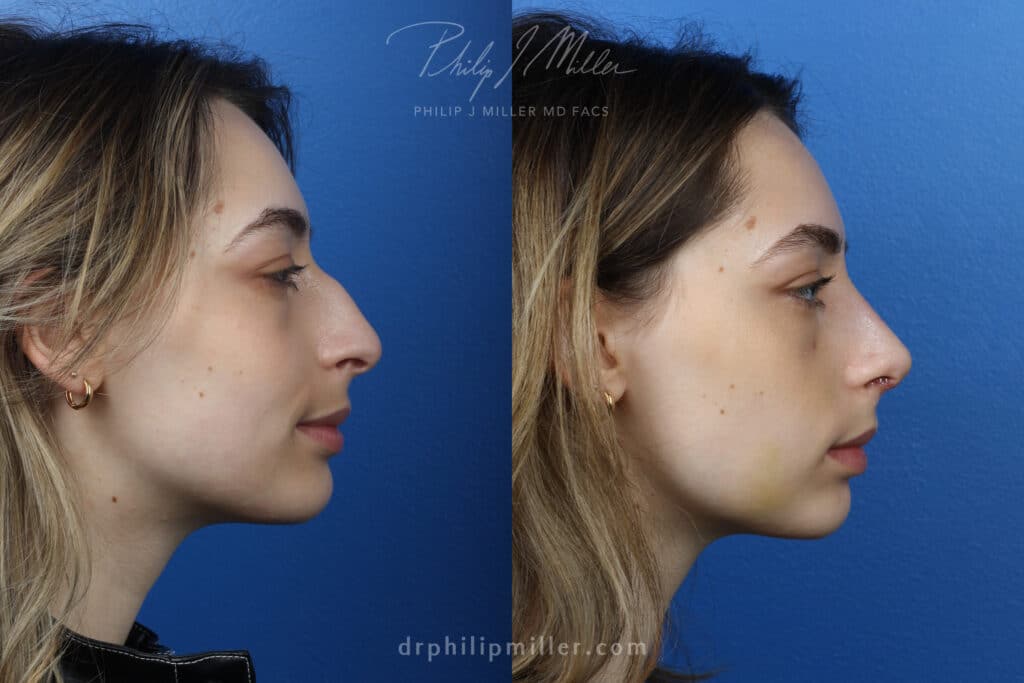
What if I don’t tape my nose after rhinoplasty?
Not all patients have to tape their nose after rhinoplasty surgery; it should only be done following instructions from a skilled board-certified facial plastic surgeon. Dr. Miller works closely with each patient to determine the benefit and necessity of nose taping. There are cosmetic and health benefits associated with taping. If the nose taping process is not followed as directed, it could lead to:
- Nose deformity
- Extended healing time
- Additional complications
- Increased swelling
How to Tape Your Nose after Rhinoplasty
There are multiple kinds of tape to use after rhinoplasty. Common choices are adhesives, like medical tape and bandages, and those that use pressure, like dental bandages. Speak to your surgeon about taping instructions best suited for your situation and healing expectations. Generally, patients should:
1. Tape the nasal bridge: Use 3-5 strips of tape about two inches long. Start at the tip of your nose and overlap upward to cover the entire bridge.
2. Wrap the tip: Use a longer piece of tape to wrap the end of the nose, creating a “U” shape while avoiding the nostrils.
3. Repeat the first step: Repeat the first step using strips to cover the bridge and ensure the “U” tape stays in place.
At first, nose taping may be necessary 24/7, depending on your specific circumstances. In this case, the tape should be removed every 2-3 days and new tape applied. After several days or weeks, nose taping may only be done at night to help with swelling and removed each morning.
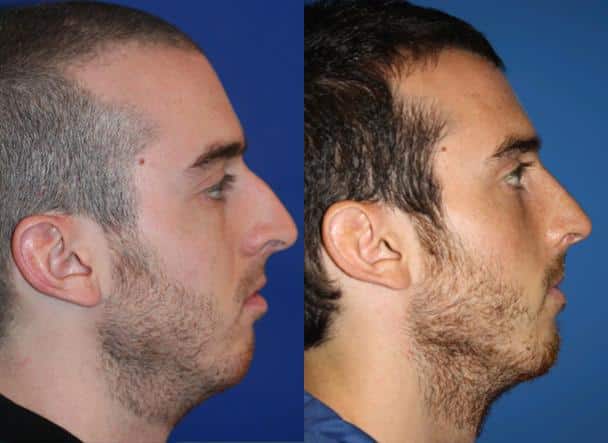
Removing tape should be done with as much care as applying the tape to prevent any harsh movements or pressure. Tweezers can be used to gently peel the tape or remove it after a shower when it is damp and starting to lose adhesiveness, or apply baby oil on the tape and that will loosen it.
How long should I tape my nose after rhinoplasty?
Nose taping is often recommended for 1-3 months after a rhinoplasty procedure. Dr. Miller provides patients with clear instructions for recovery care and taping. Patients will also visit Dr. Miller for follow-up appointments to ensure proper healing and appearance.
Schedule Your Nose Job in NYC
Dr. Philip Miller, MD, FACS, is a world-class, double board-certified plastic surgeon and a leading expert in rhinoplasty procedures and facial rejuvenation. Dr. Miller has more than 20 years of experience in surgical and non-surgical facial procedures and an artistic eye for helping patients meet their cosmetic goals. After a rhinoplasty or revision rhinoplasty procedure, may instruct patients to tape their nose, but it is not always recommended.
Dr. Miller is an innovative expert that offers personalized care and treatment plans. His goal is to empower patients and support aesthetic confidence. Dr. Miller uses the NatraLook® Process to create a positive environment where patients can discuss obstacles and desires for a unified and natural rhinoplasty result.
Contact us to schedule a consultation and learn more about nose taping after rhinoplasty.
Do I Need a Spreader Graft?
Spreader grafts are a common technique used in rhinoplasty and rhinoplasty revision. They are grafts of cartilage placed between the upper lateral cartilages and the septum to widen the middle third of the nose. These grafts assist with vestibular stenosis and help prevent depressions and concavity in the middle third of the nose.
Dr. Philip Miller is a double board-certified facial plastic surgeon in facial plastic and reconstructive surgery and head and neck surgery located in the heart of Manhattan. Dr. Miller specializes in cosmetic facial procedures and is a leading expert in rhinoplasty and facial rejuvenation. Dr. Miller and his highly acclaimed team offer customized treatments in New York City, NY, and New Orleans, LA.
Do I need a spreader graft?
A spreader graft may be useful during a variety of rhinoplasty procedures, including the following:
When a hump is removed, a spreader graft is used to strengthen and support the middle third of the nose. The hump contains delicate connections of cartilage and bone, so removing it increases the risk of the nose falling inward. Spreader grafts prevent a concave nose by adding structural support.
If there is a bend in the middle of the nose, it can be corrected with a spreader graft. In this case, the graft addresses the asymmetry of the nose and may improve the airway passages for easier breathing.
Nose trauma or a previously failed surgery can lead to depression in the middle third of the nose. A spreader graft can provide adequate support to the nose and rebuild the dorsum.
Patients that have medical issues and require better airflow can use a spreader graft to improve the internal nasal valve, the narrowest part of the nasal airway.
What is spreader graft in rhinoplasty?
During a rhinoplasty or rhinoplasty revision, a spreader graft is used to correct a specific problem. It is typically used to fix functional issues, like breathing, in the middle section of the nose between the nasal tip and below the nasal bone. In rhinoplasty, a spread graft is used to add support to the nose after a hump reduction or open the internal nasal valve for better breathing.
While the practical uses are ideal for breathing improvements, a spreader graft can also help solve cosmetic issues. A spreader graft can correct a twisted nose by only placing the graft on one side of the nose to straighten it. They can also be used in rhinoplasty revision to keep the septum straight. In some cases, they restore support that might have been lost after the initial rhinoplasty procedure.
Benefits of a Spreader Graft
A spreader graft offers many benefits, including:
- Permanent solution for functional and cosmetic problems
- Improves airway passage
- Provides structural support for long-lasting rhinoplasty results
- Balanced nose shape that is harmonious with other facial features
- Prevent future problems and revision surgeries
About the Procedure
A spreader graft can be placed during an open or closed rhinoplasty procedure. The best option is during an open rhinoplasty so that surgeons have a clear view of the treatment area for accurate placement. The actual graft is made from the patient’s cartilage, usually from the septum or ear, if the septum cartilage is minimal.
The spreader graft is usually placed on both sides of the septum to widen the internal nasal valve. The graft is sewn into place with sutures, and then the upper lateral cartilage is put back into place for the middle vault reconstruction. It is an extensive surgical procedure that requires anesthesia and adequate recovery time.
Like any rhinoplasty procedure, performing a spreader graft requires extensive recovery before final results are evident. The graft placement itself is vast and can take up to 3 hours depending on if it is a combination procedure. Any incisions are minor and heal quickly with minimal scarring. Many patients have bruising and swelling for several weeks after the surgery and can expect most of the swelling to subside within a month or two. However, it can take up to a full year before swelling is gone entirely.
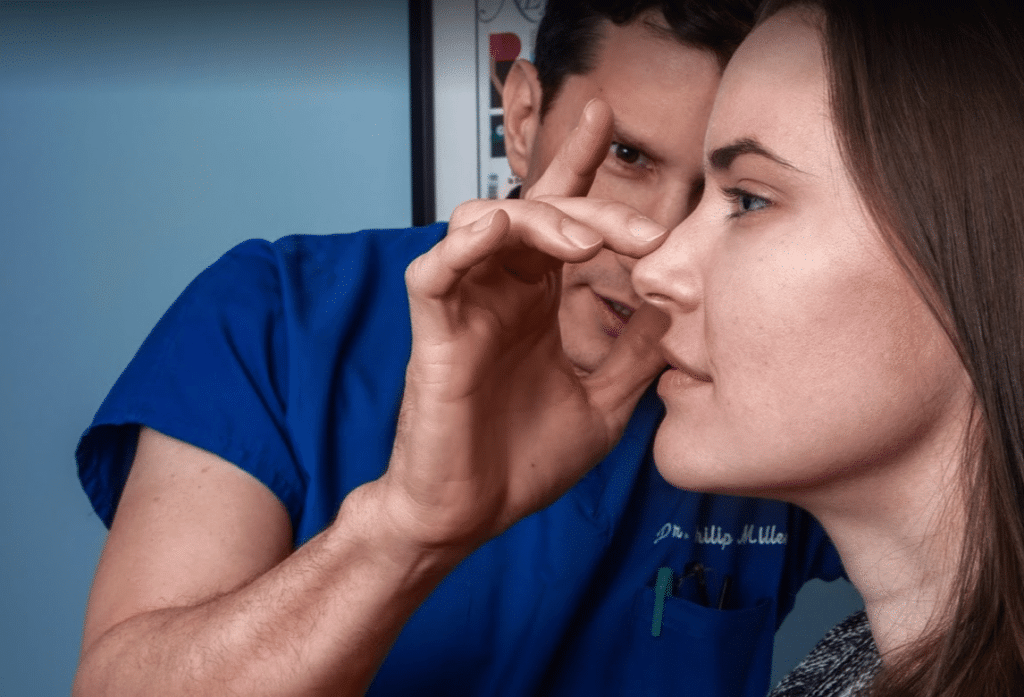
Spreader grafts before and after
In some cases, a spreader graft does not add any cosmetic value to the nose and does not produce visible outward changes. When used to improve nose function, the changes are only internal and will be apparent to the patient with better breathing.
When spreader grafts are used to add support and change the shape of a nose, there are noticeable outward changes after surgery. A spreader graft can result in dramatic changes when a nose is collapsed or twisted.
Spreader grafts in Manhattan, NYC
Dr. Miller is a top plastic surgeon in New York City and New Orleans with more than 20 years of experience and thousands of successful surgeries. Dr. Miller and his team strive to create stunning and natural results with NatraLook®. The NatraLook process expands the typical plastic surgery experience into a safe opportunity to explore aesthetic confidence. Patients work closely with Dr. Miller to create a unified vision and work through obstacles to achieve natural results.
Contact us to schedule a consultation and determine if spreader grafts are right for you.
Endonasal Rhinoplasty
Dr. Miller never uses a “cookie-cutter” or one-size-fits-all approach to nose surgery. Because every patient is unique in their facial features, your consultation will determine which surgical approach is best for your particular circumstances. Double board-certified facial plastic surgeon Philip J. Miller, MD, FACS, performs both closed rhinoplasty (endonasal) or open rhinoplasty depending on the specific needs of each patient.
Dr. Miller offers patients in Manhattan, New York, and New Orleans, Louisiana, expert rhinoplasty techniques, with the goal of bringing balance to your facial features and achieving beautiful, natural-looking results.
What is endonasal rhinoplasty?
Also called a closed rhinoplasty, endonasal rhinoplasty is an internal procedure in which all incisions are confined to inside the nostrils. The nose is not opened fully, and the nasal structure is not exposed. The work is done entirely through narrow openings in each nostril. Patients concerned about visible scarring need not worry with a closed rhinoplasty. During the procedure, Dr. Miller carefully lifts the underlying bone, cartilage, and tissue through the nostrils, so you won’t be able to see any scarring.
Open vs. Closed Rhinoplasty
While both open and close rhinoplasty procedures can achieve exceptional results, each has its own advantages and drawbacks to consider during your consultation.
During an open rhinoplasty, Dr. Miller makes a small incision in the columella – the piece of tissue that separates the nostrils at the base of the nose. Also called external rhinoplasty, this technique opens the tip of the nose to reveal the internal structure. Dr. Miller can reshape the nose and repair damage while keeping structural support intact. An open rhinoplasty provides improved precision, enhanced visibility, and enhanced structural support. However, there can be minor scarring under the base of the nose. An open rhinoplasty may also require a slightly longer recovery process compared to a closed technique.
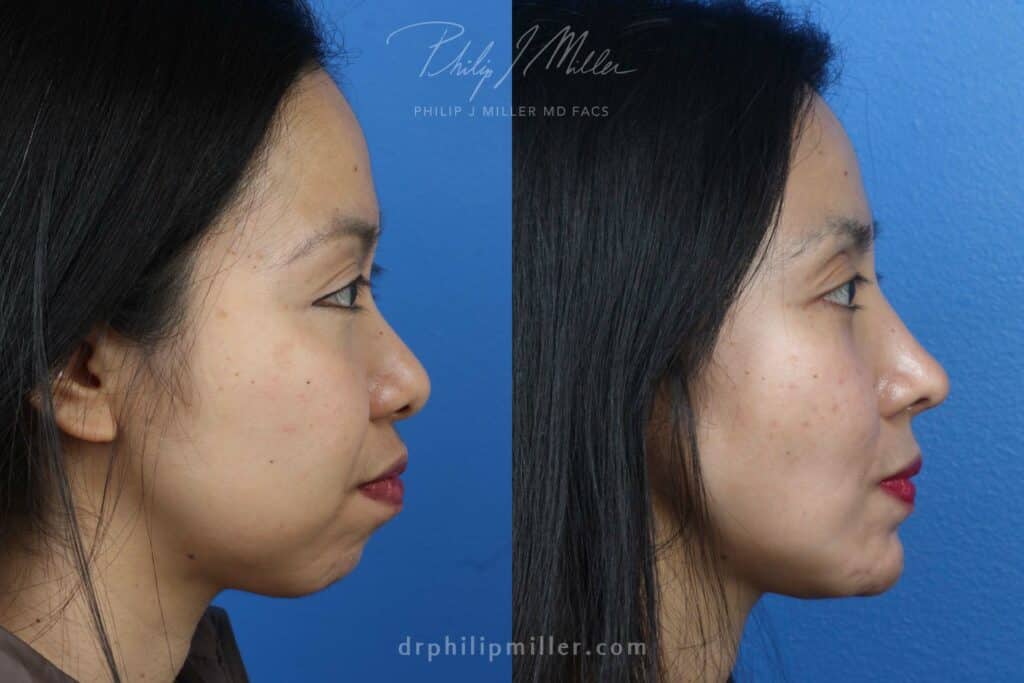
Dr. Miller typically recommends open rhinoplasties for patients with complex structural concerns, such as a severely crooked nose, nasal trauma or deformities, an asymmetrical tip, a large nasal tip, or a large dorsal hump (bump on the nasal bridge). For these patients, the possibility of a nearly imperceptible scar is a good trade-off for the most natural nose reshaping possible.
A closed rhinoplasty is especially appealing for those who want to make minor modifications to their nose. Dr. Miller might also recommend this approach if you have breathing problems, such as chronic sinusitis. It is a more conservative type of rhinoplasty, which means it may not produce the more dramatic results achieved with an open rhinoplasty.
The closed technique is ideal for minor adjustments to the nasal tip and bridge. If you have a dorsal hump, wide nasal bridge, or enlarged nasal tip, endonasal rhinoplasty can deliver subtle results with little impact on the surrounding tissue.
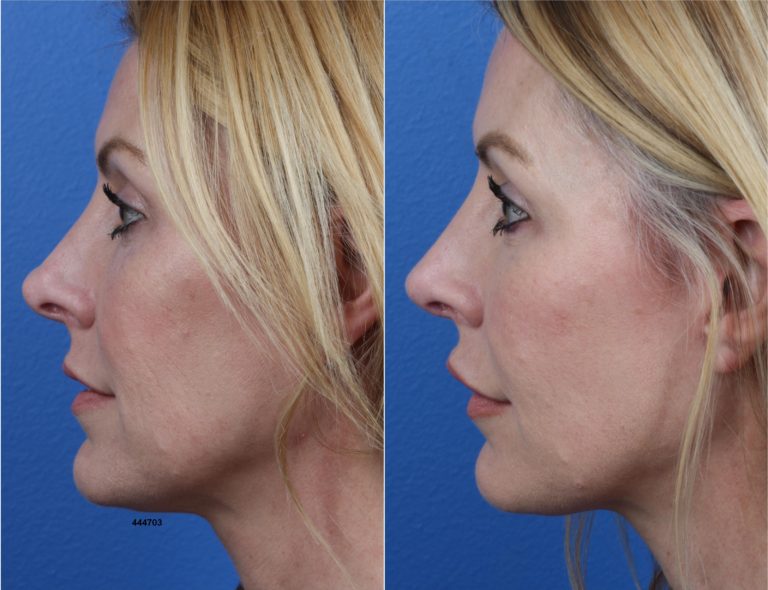
Benefits of Endonasal Rhinoplasty
Because all stitches are located inside the nose, patients will not have any visible scarring after the surgery. Recovery may also be a bit faster, with many patients returning to work and other activities within one week rather than the two weeks usually allotted for open rhinoplasty recovery. Other benefits include:
- Decreased operative times
- Profile adjustments are easier to judge because the structural support remains undisturbed
- Reduced postoperative edema
- Quicker return to a normal appearance
How is Endonasal Rhinoplasty Performed?
You can undergo endonasal rhinoplasty using local anesthesia with sedation or general anesthesia. To begin, Dr. Miller will make incisions inside the nostrils to separate the skin from the cartilage. Dr. Miller can then begin the process of reshaping the cartilage or shaving off or adding bone (bone graft) through the narrow openings in each nostril. Once the shaping is complete, absorbable stitches will close any incisions. You will have a cast or nose splint after surgery to protect the nose and maintain the new shape. The procedure typically takes 1-2 hours to complete.
Recovery After Endonasal Rhinoplasty Surgery
You will need to arrange for someone to drive you home after your surgery. The cast or splint helps support the nose as it heals for the first week. You can expect to take a few days off from work so you can comfortably recover at home. It is best to keep your head elevated to help reduce any swelling. To ensure faster healing, avoid the following:
- Strenuous exercise/activity
- Blowing your nose
- Swimming
- Sleeping facedown
- Excessive chewing
- Drinking alcohol
- Smoking
- Wearing eyeglasses
- Pulling tight clothing over your head
We will remove your cast or splint after one week. You can usually return to work and normal activities within 1-3 weeks, but you should refrain from strenuous physical activity for 3-6 weeks. You will begin to see the swelling and bruising subside within 2-3 weeks, at which time you will start to appreciate the results.
Full results usually take 6-12 weeks to be seen, while your healing will continue for the entire first year. Dr. Miller and his team will follow you through this entire process.
Scarring After Closed Rhinoplasty
The primary benefit of a closed rhinoplasty is that there’s no external evidence of the procedure. All stitches are located inside the nose, so you may feel more comfortable resuming your normal activities sooner than you might after an open rhinoplasty.
Is Endonasal Rhinoplasty Right For You? Ask the Expert
Open and closed rhinoplasty surgery are different surgical approaches, but one is not superior to the other. To determine the best procedure for you and ensure the best possible results, Dr. Miller offers a proprietary consultation process called NatraLook®. During your NatraLook consultation, he evaluates your nose and facial features while listening to your concerns and goals. This process evaluates and expands the typical plastic surgery experience into a safe, collaborative environment where you can explore your aesthetic confidence. This opportunity allows you and Dr. Miller to create a unified vision for your results and the most natural outcome possible.
To learn more about the different types of rhinoplasty procedures Dr. Miller performs and to find out which technique is best for you, contact our New York City plastic surgery clinic today.
Your Most Beautiful Nose: Understanding Your Nose Type
Manhattan, New York, is a diverse city representing many ethnicities. While everyone has a unique nose shape, common ethnic features impact rhinoplasty concerns and ideal outcomes. Rhinoplasty, better known as a nose job, is a surgical procedure that improves the appearance of the nose by:
- Reshaping
- Reducing
- Straightening
- Removing a hump
- Refining the tip
Customizable rhinoplasty solutions are essential to achieve the most natural results, especially for ethnic rhinoplasty patients. Ethnic rhinoplasty is a procedure performed on patients of different ethnicities and can improve the nose while preserving ethnic identity.
Philip J. Miller, MD, FACS, is a double board-certified facial plastic surgeon surgeon with skill, expertise, and an artistic eye. He achieves impeccable and life-changing results for his patients and is highly qualified to perform even the most complex rhinoplasty procedures. He uses a unique approach with ethnic patients as their goals and concerns typically vary from Caucasian patients.
Dr. Miller’s Manhattan office works with many different nose types, including:
African American Noses
African American rhinoplasty is an ethnic reshaping procedure designed with specific and unique characteristics and concerns of African American patients. African Americans tend to have:
- Wide, low bridge
- Bulbous, under-projected tip
- Wide alar base
- The goal for many African American rhinoplasty procedures is to:
- Low bridge
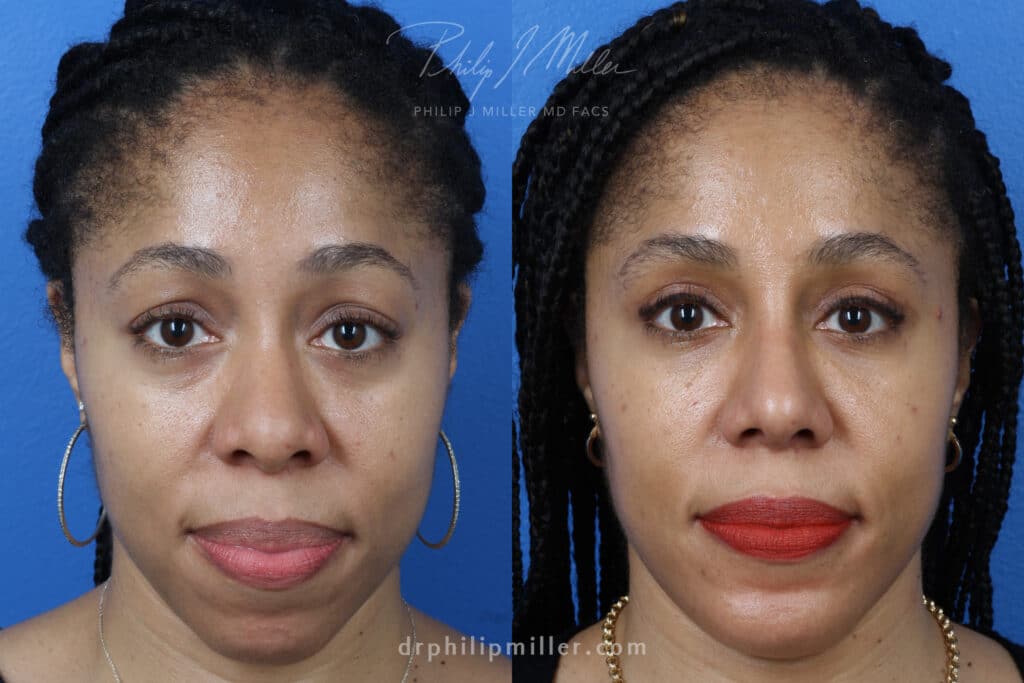
Dr. Miller recognizes the differences in nasal anatomy and can improve the nose while maintaining harmony with other facial features and ethnic heritage. As a skilled and experienced surgeon, Dr. Miller creates natural outcomes and avoids complications common in African American patients, such as keloid scar formation.
Asian Noses
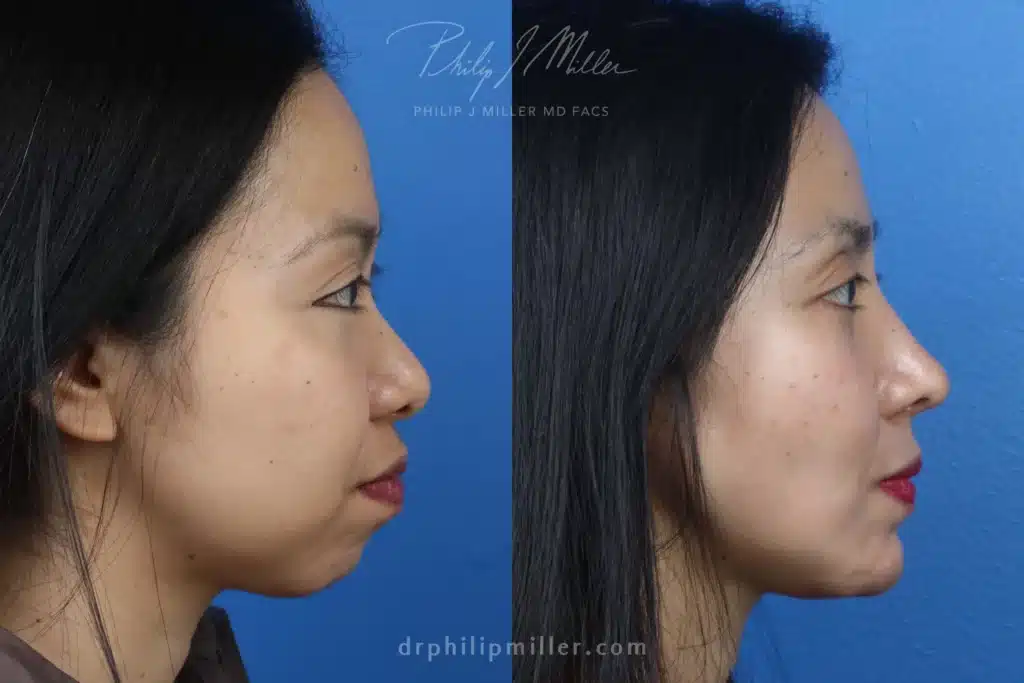
Each ethnicity has a different look and requires a specialized approach to rhinoplasty, including Asian patients. Many Asian patients experience common nose characteristics, including:
- A flat nasal profile
- A slight nasal bridge
- Flared nostrils
- A wide nasal tip
- Poor nasal tip strength
Asian patients often want to:
- Reduce flaring
- Have tip or bridge implants for a more prominent profile
While Korea is an Asian country, Korean rhinoplasty varies from the approach to Asian rhinoplasty. Korean patients experience a flatter nasal profile, slight nasal bridge, broad nasal tip, and wide nostrils. Without overcorrecting, Dr. Miller can:
- Narrow nostrils
- Fix an overly punched tip
- Correct an over-augmented bridge
Dr. Miller is committed to creating a personalized treatment plan with an approach central to your ethnicity. With more than 20 years of experience, Dr. Miller can produce natural and beautiful results in his Manhattan, New York location.
Hispanic/Latino Noses
There are more than 52 million Hispanic and Latino individuals in the United States, making Hispanic rhinoplasty an increasingly popular procedure in Manhattan. There is so much diversity within the Hispanic and Latino communities, it requires special consideration for small ethnic groups regarding rhinoplasty procedures. Hispanic patients share common nasal features such as thick skin and a bulbous nasal tip that is difficult to refine with traditional methods. Other categories include:
- Spanish heritage: a large bridge
- Caribbean heritage: wide, flat nostrils
- Central and South American heritage: flatter nasal tips and bridges
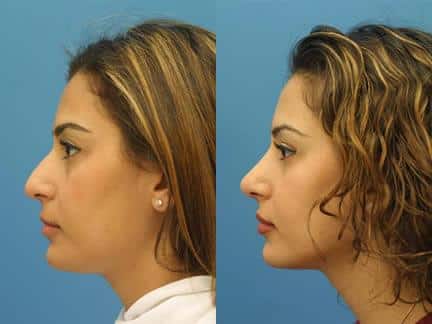
These differences call for three distinct rhinoplasty procedures:
- High bridge with a hump: The cartilage is shaved down, and the bone is rasped to remove the hump
- Under-projected, dependent tip: The tip of the nose is raised and projected with supplemental cartilage
- Shorter, flatter nose with a broad nasal base, thick skin, and a wide tip: The shape of the nose is refined by narrowing the base and raising the bridge
Dr. Miller works extensively with patients on how to approach the procedure and how to maintain a natural and ethnic-looking appearance.
Middle Eastern Noses
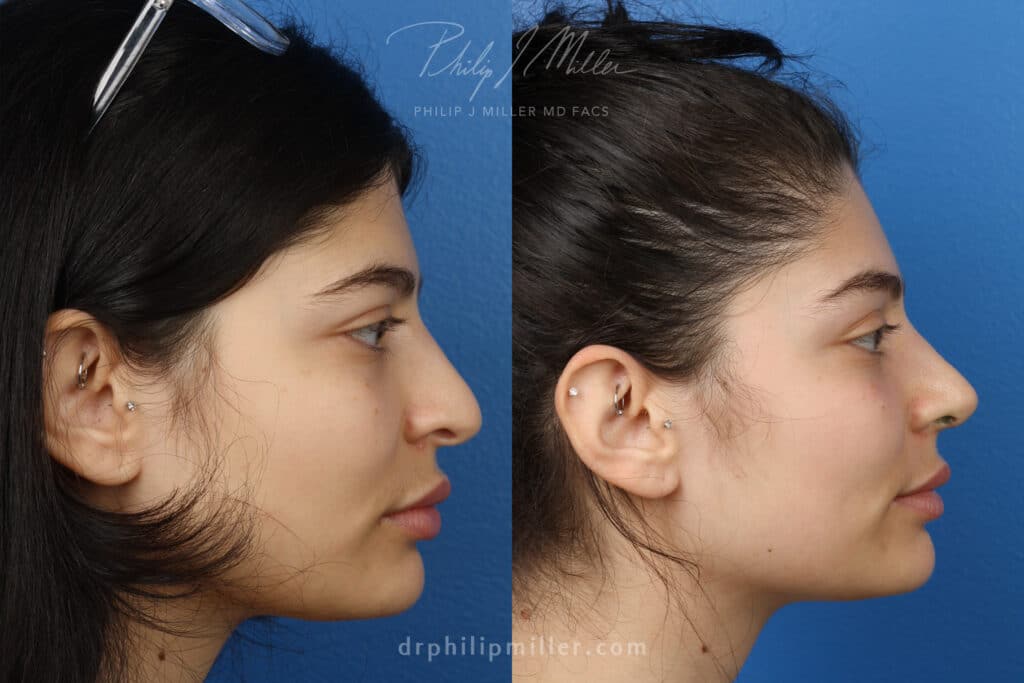
Mediterranean and middle eastern rhinoplasty patients experience common nasal characteristics such as:
- Thicker facial skin with fattier tissue
- Longer noses and a higher bridge
- Droopy tips
- Nasal humps
- Asymmetrical nostrils
- Wide bones
The goal of middle eastern rhinoplasty is to create:
- More symmetry
- Facial balance
Less experienced surgeons may create undesirable results, but Dr. Miller is a skilled surgeon that is knowledgeable about ethnic nose reshaping techniques. He can help create the best nose with ethnic rhinoplasty or revision rhinoplasty.
Indian Noses
With special techniques and years of experience, Dr. Miller can improve the shape of Indian noses without impacting ethnic identity with Indian rhinoplasty. Common nose characteristics for this ethnicity include:
- Rounder nasal tip
- Wider nasal structure
- Thicker skin on the nose
- A nasal shape that slopes downward
- Hump or bump on the nasal bridge
You can schedule a consultation in Dr. Miller’s Manhattan office to discuss all your concerns and identify if Indian rhinoplasty is right for you.
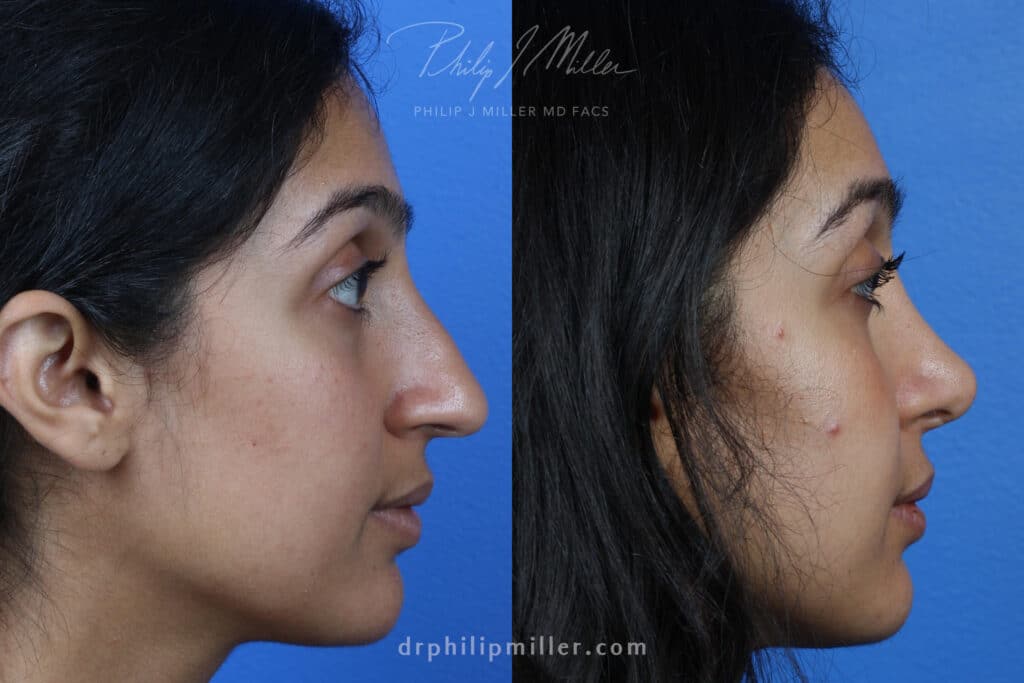
Other Types of Noses
There are many other ethnic nose shapes such as Greek, Persian and Jewish noses. Greek noses typically have a straight bridge without bumps or curves. It is a common reference as many rhinoplasty patients want a straight bridge for a sleek-looking profile.
A Persian nose has:
- Large nasal profile
- Downward sloping of the nasal bridge
- Bulbous nasal tip
A Jewish nose has:
- Amorphous nasal tip
- Over projected nasal tip
- Large dorsal hump
Getting Positive Results with Ethnic Rhinoplasty
Dr. Miller utilizes the NatraLook® Process to ensure the most natural and pleasing results for any procedure, especially complex treatments like rhinoplasty. The NatraLook Process is critical to achieving a unified vision and executing intended results specific to ethnicity. Evaluating the entire face is vital to achieving balance, beauty, and natural-looking features.
#1 NYC facial plastic surgeon, Dr. Miller, has years of experience with ethnic patients and has the skills to create natural and ethnically centered rhinoplasty procedures. Contact Dr. Miller’s Manhattan, New York, office to schedule a consultation and learn more about ethnic rhinoplasty.
What is Dorsal Reduction?
Dorsal reduction rhinoplasty surgery is a procedure that removes excess cartilage and bone from the nose, refining its appearance and improving its proportion to the rest of the face.
Philip J. Miller, MD, FACS, a double board-certified facial plastic surgeon in Manhattan, New York, and one of the country’s foremost experts in rhinoplasty, can assist female and male patients alike in achieving a nose they’ll love. You may elect traditional dorsal reduction rhinoplasty to reshape or reduce the nose. Other patients may benefit from non-surgical rhinoplasty for subtle corrections that achieve their desired aesthetic goals.
What is dorsal reduction?
Dorsal reduction rhinoplasty is a surgery that removes excess cartilage, bone, and skin from the nose, giving it a straighter, more streamlined look. This can help enhance the appearance, create facial symmetry, and improve breathing through the nose by reducing nasal obstruction or deviation.
The procedure can make the bridge of the nose narrower and straighter, and is often performed on patients whose noses are too large for their facial features or who have noses with an unusual shape. Dorsal reduction is often performed on people with prominent noses, such as those of Italian or Greek heritage.
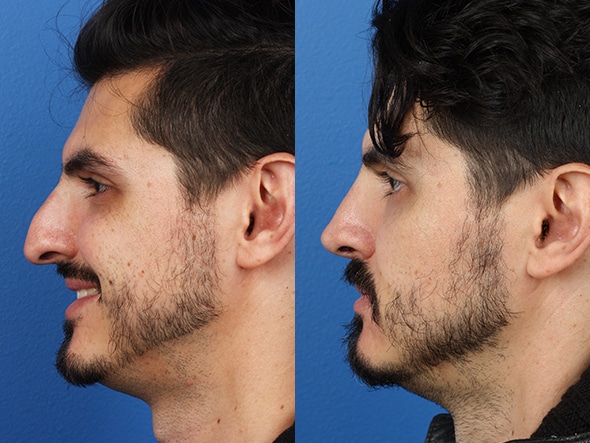
What causes a dorsal hump?
A dorsal hump appears on the slope of the nose from the bridge to the tip and can affect your facial profile. A dorsal hump is most noticeable when viewed from the side of the face.
The majority of dorsal humps are inherited genetically. As a result, if your parents or siblings have a prominent dorsal hump, you may as well. Dorsal humps may occur due to a traumatic physical injury—such as a sports injury or car accident—if the bone or cartilage heals unevenly. Whatever the cause of a dorsal hump, Philip Miller, MD, FACS in Manhattan can correct it and give you an aesthetically pleasing, balanced profile.
Benefits of Dorsal Reduction

The benefits of dorsal reduction rhinoplasty include improved self-confidence and a positive self-image. However, since dorsal humps are often the result of genetic heritage, the procedure may cause identity issues for some ethnic patients. This is why it is so important to rely on an expert surgeon’s skills to achieve the goals of an ethnic nose job without affecting other ethnicity-related facial features.
How is dorsal reduction performed?
Open Rhinoplasty. During an open rhinoplasty, the surgeon makes a small Z-shaped incision between the nostrils on the underside of the nose. The open approach enables the surgeon to make more precise and accurate adjustments to your nose’s shape. Although open rhinoplasty leaves a small scar, it fades quickly with proper care.
Closed Rhinoplasty. Closed rhinoplasty is a procedure in which the surgeon makes incisions inside the nose without affecting the skin. The primary disadvantage of this approach is that the bone, cartilage, and tissue are not visible to the surgeon. However, this procedure results in less swelling than open rhinoplasty and can correct minor flaws.
MicroRhinoplasty. During a MicroRhinoplasty procedure, Dr.Miller accesses the treatment area via a small incision in the nostril. Then, using a specialized microrasp, he meticulously removes the protruding bony layers until the desired contour is achieved. Patients experience minimal discomfort, swelling, and bruising and typically resume normal activities within a few days.
Liquid Rhinoplasty. A liquid—or nonsurgical—rhinoplasty uses dermal fillers to reshape the nose without stitches or incisions. While liquid filler can’t make a nose appear smaller, it can correct minor indentations or asymmetries without requiring surgical intervention.
Recovery After Dorsal Reduction
Most patients are pleasantly surprised by how little pain they experience following dorsal reduction rhinoplasty surgery. The most unpleasant aspect of postoperative recovery is difficulty breathing through the nose for several days because of swelling. This difficulty usually resolves within a week or two. Expect some swelling around your eyes for several weeks. Once the swelling diminishes, you’ll start to see improvement.
You’ll need to follow certain precautions during your recovery period. Because bending or lifting can exacerbate swelling, it’s not recommended for the first three weeks following surgery. No strenuous activity such as running, weight lifting, cycling, or cardio training should be resumed for three weeks. Contact sports should be avoided for six weeks to allow the bones to heal completely. You may drive once the swelling has subsided sufficiently to allow for clear vision. Air travel is permitted 2-3 weeks after your surgery.
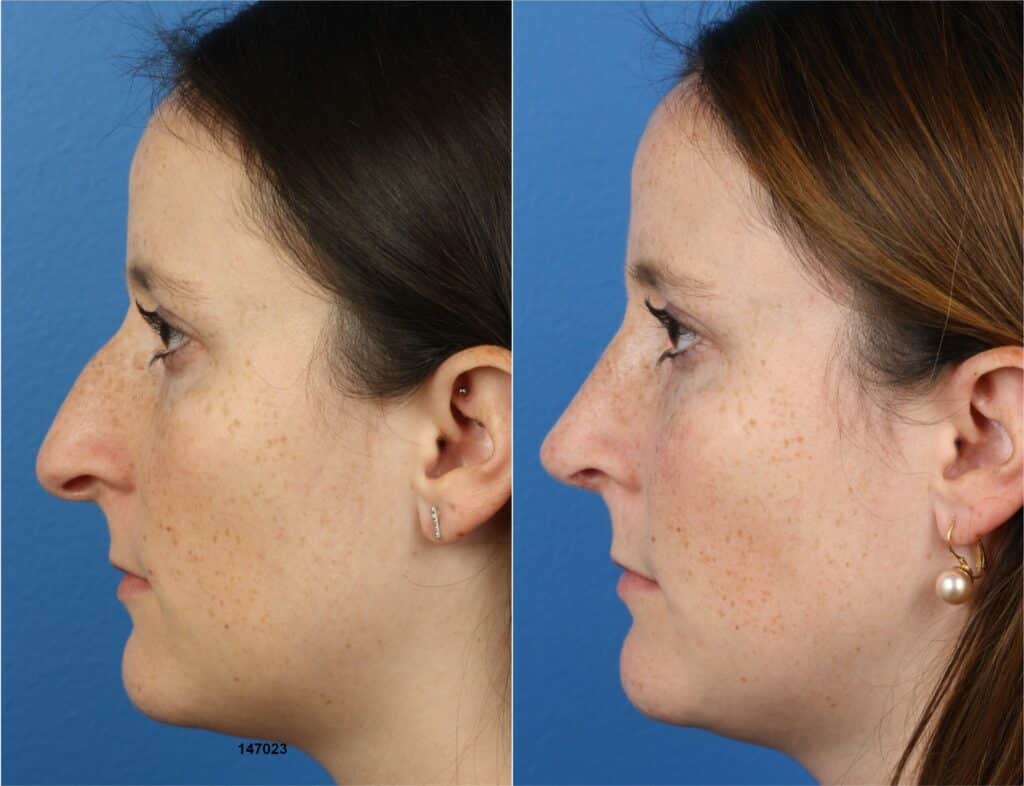
Scarring After Dorsal Reduction
The size and location of scars will depend on how extensive your treatment is because dorsal reduction involves removing sections of bone, cartilage, and skin tissue.
Scars from this procedure are typically hidden within the nasal skin creases and won’t be visible when you look straight ahead. Many patients choose topical treatments to minimize scarring.
Is Dorsal Reduction Right for You? Ask the Expert
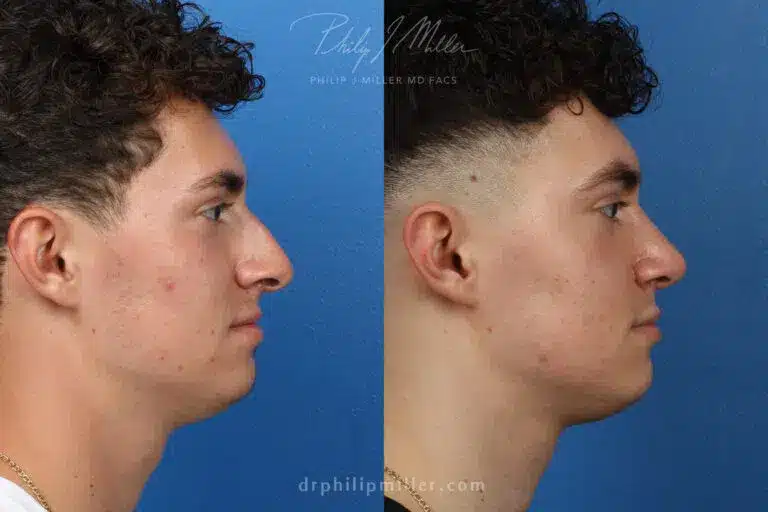
Why should you consult with Dr. Miller about your dorsal reduction procedure?
- Dr. Miller has over two decades of experience in facial plastic surgery.
- He has performed over 5,000 successful procedures.
- He is a facial plastic surgeon of international renown.
- He blends art and science to provide his patients with beautiful, natural-looking results.
In addition to these qualifications, Dr. Miller offers his patients the exclusive NatraLook process, which combines minimally invasive techniques and advanced procedures to help each patient achieve the Aesthetic Confidence® they desire.
Schedule a Dorsal Reduction Consultation in New York
To learn more about dorsal reduction rhinoplasty in Manhattan, contact our office to set up a consultation with Dr. Miller, #1 NYC facial plastic surgeon. You can fill out our convenient contact form or call us. One of our patient advisers will be happy to help you start the journey to a new, improved you.
What is External Rhinoplasty?
One of the most important steps during your rhinoplasty consultation is determining whether you are a better candidate for external (open) or endonasal (closed) rhinoplasty. While both procedures can achieve exceptional results, the exact technique that your facial plastic surgeon uses will be determined by your unique concerns and nasal structure. This blog puts the spotlight on what external rhinoplasty is and its advantages.
Whether you are a better candidate for external rhinoplasty or a different technique, double board-certified facial plastic surgeon, Philip J. Miller, MD, FACS, has the artistic skill and experience to reshape or reconstruct your nose for enhanced facial symmetry. He is your Manhattan, New York, and New Orleans, Louisiana, expert on all types of rhinoplasty techniques, and it is his goal to bring balance to your features and achieve beautiful, natural-looking results.
What is External Rhinoplasty?
External rhinoplasty is a rhinoplasty technique in which Dr. Miller makes a small incision in the columella (the piece of tissue that separates the nostrils) in a Z-shaped pattern. This common technique opens the tip of the nose to reveal its internal structures, improving surgical access and allowing Dr. Miller to fold the nasal skin upwards.
Because of enhanced visibility while maneuvering through the bone, cartilage, and tissue that make up the nose, Dr. Miller can reshape the nose and repair damage without jeopardizing its structural support.
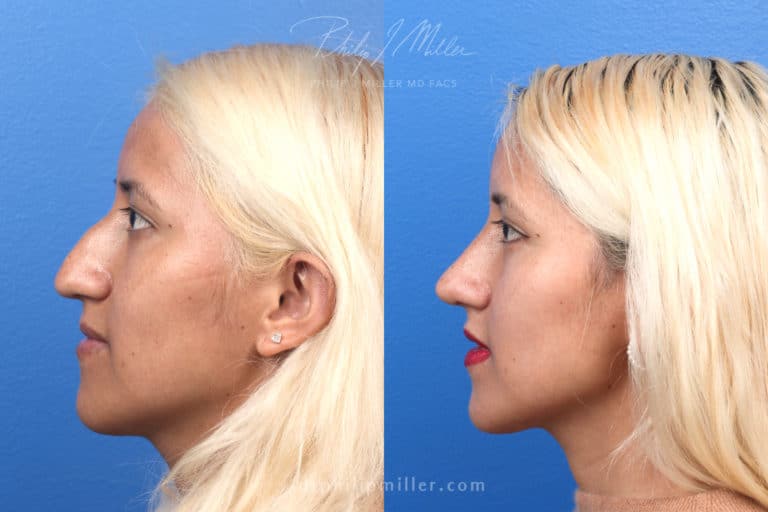
External vs. Endonasal Rhinoplasty
An endonasal rhinoplasty is a procedure in which all incisions are confined to the inside of the nostrils. During the procedure, Dr. Miller carefully lifts the underlying bone, cartilage, and tissue through the nostrils, and while visible scarring is prevented, considerable challenges and technical limitations are associated with the lack of surgical access.
A closed rhinoplasty is especially appealing for those who want to make minor modifications to their nose. It’s also ideal if you have breathing problems, such as chronic sinusitis. And with no external incisions, the skin between the tip and nasal bridge remains intact. This means a shorter recovery time for patients. But this more conservative rhinoplasty isn’t right for everyone.

Dr. Miller typically recommends external rhinoplasties for patients with more complex structural concerns, such as:
- A severely crooked nose
- Nasal trauma or deformities
- An asymmetrical tip
- A large nasal tip
- A large dorsal hump (bump on the nasal bridge)
External rhinoplasty is also best for revision rhinoplasty in most cases. If you’ve had rhinoplasty in the past and are unhappy with the results, Dr. Miller will typically recommend external rhinoplasty to address your concerns.
Benefits of External Rhinoplasty
There are two main advantages to an external rhinoplasty procedure:
Improved precision: The greatest benefit of performing external rhinoplasty is better access. Opening the columella allows Dr. Miller to see the internal structures of your nose. As a result, he can correct complex nasal deformities with precision and accuracy. Clear visibility also allows him to preserve as much of your tissue, cartilage, and bone as possible because he can reshape rather than simply remove them. Many patients may have underlying asymmetry issues with their cartilages, and these can only be visualized and treated through an open approach.
Preservation of structural support: Because of better visualization of almost the entire nasal framework, individual components can be accessed in their natural, undisturbed alignment. And by expanding his entry to the nasal components, Dr. Miller can maintain the nose’s structural stability. He’s able to create dramatic results without disrupting much of the surrounding bone, cartilage, and tissue.
How is External Rhinoplasty Performed?
Dr. Miller begins an external rhinoplasty by making a small incision in the columella. He will lift away nasal skin, pulling it up so he can work on bone and cartilage in their natural alignment. After he makes the necessary alterations to reshape the nose or repair any damage, he will re-drape the skin and suture it in place. A small splint is typically taped over the nasal bridge and will be removed one week after surgery.

Recovery After External Rhinoplasty
You will experience nasal stuffiness after your procedure which will subside after the first several weeks. The splint, which helps protect and support your nose, will be removed about one week after your surgery. When the splint comes off, you may see some bruising and swelling under the eyes which are temporary and can easily be covered by make-up. Most patients are usually back to performing most activities after 2-4 weeks.
Dr. Miller will provide you with an extensive list of rhinoplasty post-op instructions. This is by far the most effective way to help ensure a smooth post-op recovery process and reduce the chance for risks and complications.
Scarring After External Rhinoplasty
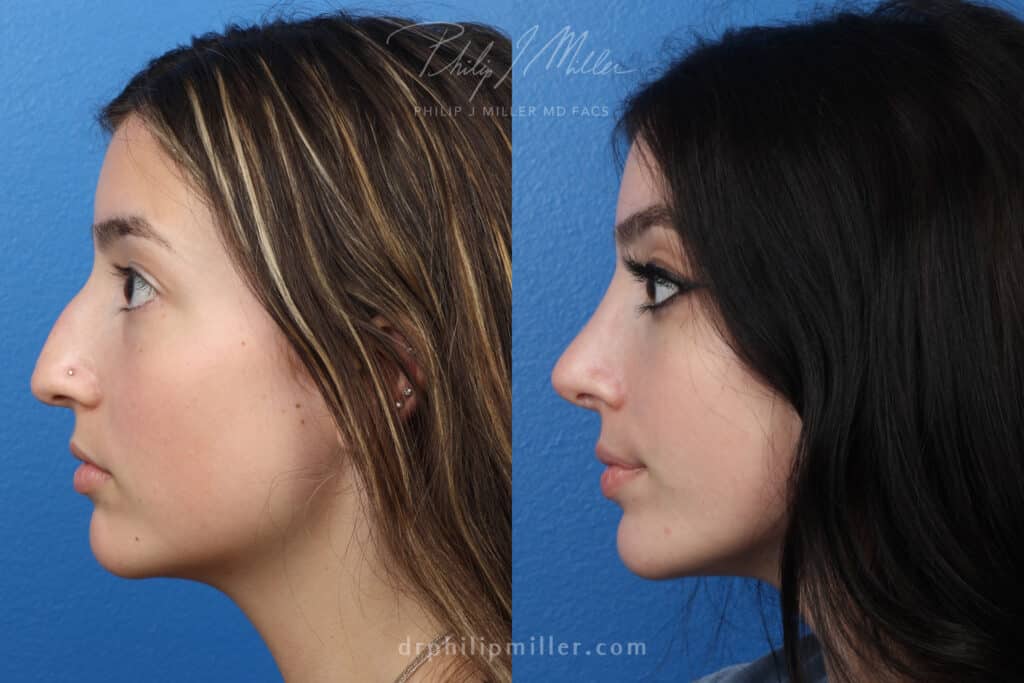
Since an open rhinoplasty requires an external incision, you may have minor scarring after the procedure. Fortunately, the Z-shaped incision is very small, so the scarring should fade with time.
Dr. Miller also takes your skin and facial structure into consideration before making the incision. This step ensures that the scar is barely visible as it is between the nostrils at the base of the nose. In most cases, you will be the only one that knows it’s there.
Is External Rhinoplasty Right For You? Ask the Expert
Determining the best type of rhinoplasty for you depends entirely on the concerns you want to address. Neither technique is necessarily better than the other.
To ensure you achieve the best results possible, Dr. Miller offers a proprietary consultation process called NatraLook. During your NatraLook consultation, he evaluates your nose and facial features while listening to your concerns and goals. This process expands the typical plastic surgery experience into a safe, collaborative environment where you can explore your aesthetic confidence and create a unified vision for your outcome.
Contact an Expert Facial Plastic Surgeon to Learn More About Rhinoplasty in New York City
To learn more about the different types of rhinoplasty procedures Dr. Miller performs and to find out which technique is best for you, contact our New York City plastic surgery clinic today.
5 Clues You Might Need Revision Rhinoplasty
Problems with your rhinoplasty procedure? Not happy with the results? Don’t lose hope—you can still achieve the look and functionality you want with revision rhinoplasty. Revision rhinoplasty is a surgical procedure to correct undesirable outcomes or treat persistent issues the original surgery did not address.
Philip Miller MD, FACS, a double board-certified facial plastic and reconstructive surgeon, can perform successful rhinoplasty and revision rhinoplasty procedures in Manhattan, New York. Dr. Miller has more than two decades of experience performing surgical and non-surgical procedures and can help you reach aesthetic confidence with revision rhinoplasty.
Why is revision rhinoplasty so common?
Revision procedures are common because the initial rhinoplasty is one of the most complex of all plastic surgery procedures. Some plastic surgeons do not have the skills, experience, and training to perform this procedure well, leading to botched surgeries and undesirable results.
The nose contains thin cartilage that requires expert handling to achieve successful cosmetic or functional outcomes. A study from the Aesthetic Surgery Journal found the average rate for revision rhinoplasty to be nearly 10%. Other factors that include increased revision rhinoplasty rates include:
- Outdated techniques or equipment
- Lack of doctor-patient communication
- Complications that impact the healing process and results
There are several common indicators that revision rhinoplasty may work for you. Take a look:
Clue #1: Your Nose is Not Symmetrical
Many patients feel their nose looks asymmetrical after rhinoplasty and that it was not adequately shaped. A poorly performed rhinoplasty procedure can result in a nose that appears uneven, disproportionate, or even off-center. Revision rhinoplasty can create a more natural, even look to compliment your entire facial structure.
After completely healing from rhinoplasty, you can assess the symmetry of your nose, and if you are unsatisfied, revision rhinoplasty may be right for you.
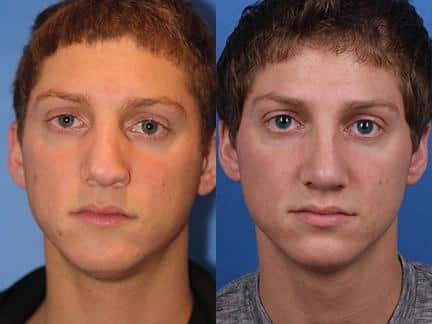
Clue #2: Your Results don’t Look Natural

An initial rhinoplasty procedure may have removed too much or too little tissue and can lead to an unnatural nose shape. It can also cause a build-up of scar tissue that needs to be surgically removed. Unnatural-looking noses can be resolved with revision surgery. Potential unnatural-looking results include:
- Pinched Tip: A frequent complaint where the end of the nose appears compressed and leads to unwanted aesthetics and impaired breathing. This occurs when too much cartilage is removed from the tip of the nose, diminishing support over time.
- Short Nose: Just as it sounds, a nose can appear short and stubby due to the removal of too much cartilage. Specialized grafts act as support and restore a longer, more natural-looking shape.
- Crooked Nose: Typically derived from nasal trauma or a result of an initial rhinoplasty, a crooked or twisted nose is uneven and unnatural. Revision can rearrange the cartilage and bone to create a symmetrical, pleasing look.
Dr. Miller utilizes the NatraLook® Process to ensure the most natural and pleasing results. The NatraLook Process is critical to achieving a unified vision and executing intended results. Evaluating the entire face and how features relate to each other, as well as skin quality and thickness, all play a part in creating a beautiful, natural look.
While an unsatisfactory rhinoplasty can be very upsetting to a patient who has invested time and money into the process, many issues can be resolved with revision rhinoplasty. Dr. Miller performs revision procedures in his Manhattan, New York office to restore your confidence and achieve a natural look.
Clue #3: You are Disappointed in Your Results
If doctor-patient communication was lacking, or the procedure did not go as planned, many patients can feel disappointed in the results. Skill and experience are not the same. Surgeons may know how to do some nose shapes and resizing but may not have as much experience with a broader range of requests and or techniques. Your nose should be proportional and harmonious with other facial features, which means rhinoplasty is not a one-size-fits-all endeavor.
Even if the shape is ideal, patients may find other imperfections that cause dissatisfaction. Revision rhinoplasty can refine subtle areas such as:
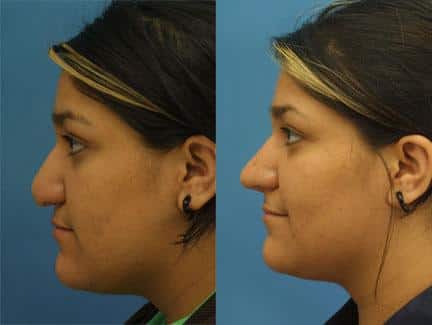
- Narrowing the nostrils
- Lifting the nasal tip
- Thinning or lifting the tissue that separates the nostrils
- Smoothing bumps on the surface of the nose
Revision rhinoplasty is a solution for major or minor alterations so that you feel good about your look. Dr. Miller uses his years of expertise to create patient-centric plans that result in stunning aesthetics to satisfy individual beauty goals.
Clue #4: Your Nose isn’t Working Properly
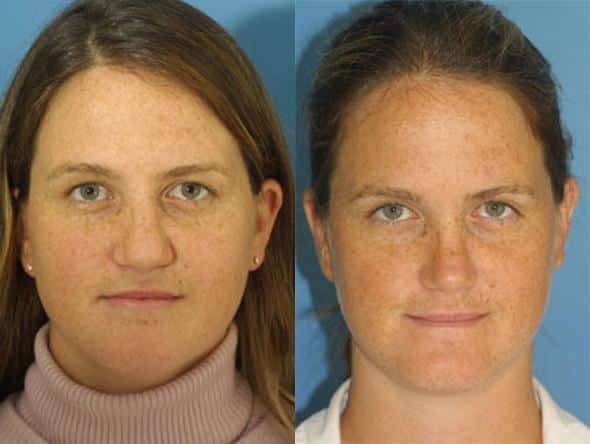
Not only should your nose look amazing, but it should also function properly. Improper nose function can be due to rhinoplasty surgery that does not heal properly or a functional issue that was not resolved or was created from a rhinoplasty procedure. The nose is a significant structure that impacts breathing and sinus issues. Revision rhinoplasty can help you get your dream nose and optimize function to reduce or eliminate problems that can interfere with breathing and sleep.
Clue #5: An Injury Occurred Since Your First Surgery
Rhinoplasty is a superior choice for nose shaping and sizing, but it does not make your nose invincible. The nose is still susceptible to injury and trauma, especially within a year or two after surgery. Due to the restructuring of cartilage and tissue, the nose can often be more fragile. If you endure an injury or trauma to the nose, it can be repaired through revision rhinoplasty. Dr. Miller works closely with Manhattan patients to ensure cosmetic and functional concerns are addressed when trauma or injury has occurred.
How Long Should You Wait for Revision Rhinoplasty?
Healing varies by individual, but most surgeons request patients wait 12-18 months before undergoing secondary rhinoplasty surgery. The healing process is long and crucial for the nose to take its final form or function. The duration of swelling varies by patient and can cause the nose to look different than it will when completely healed. Rushing into a revision surgery is dangerous and can cause unnatural and unsatisfactory results.
Choosing Your Revision Rhinoplasty Surgeon
Plastic surgery is not a guaranteed process, but choosing an expert surgeon with years of experience and developed skills can positively impact results. Do not assume all plastic surgeons are the same—research a surgeon and their practice before committing, and do not be afraid to ask hard questions. A consultation is a time to learn more about the procedure, a surgeon’s credentials, and experience.
Dr. Miller is a highly reputable, double board-certified plastic surgeon with more than two decades of experience in cosmetic medicine. With his expert team, Dr. Miller has a high success rate of facial surgery procedures and has been voted among the Best Doctors in America for the past 10 years and Top Doctor of New York City. He uses innovative techniques for rhinoplasty and revision rhinoplasty that helps patients achieve their desired look and function.
Contact us today online or by calling 646-791-3025 to see if revision rhinoplasty is right for you.
5 Rhinoplasty Trends in 2022
Rhinoplasty surgery was the most frequently requested cosmetic surgery in 2020, with over 352,000 procedures performed.
Facial plastic surgeon, Dr. Philip Miller in New York City—one of the country’s leading experts in rhinoplasty and facial rejuvenation—can help you achieve a nose you’ll love. You may choose traditional rhinoplasty to reduce or reshape the nose. For other patients, non-surgical rhinoplasty is the right choice to achieve their aesthetic goals.
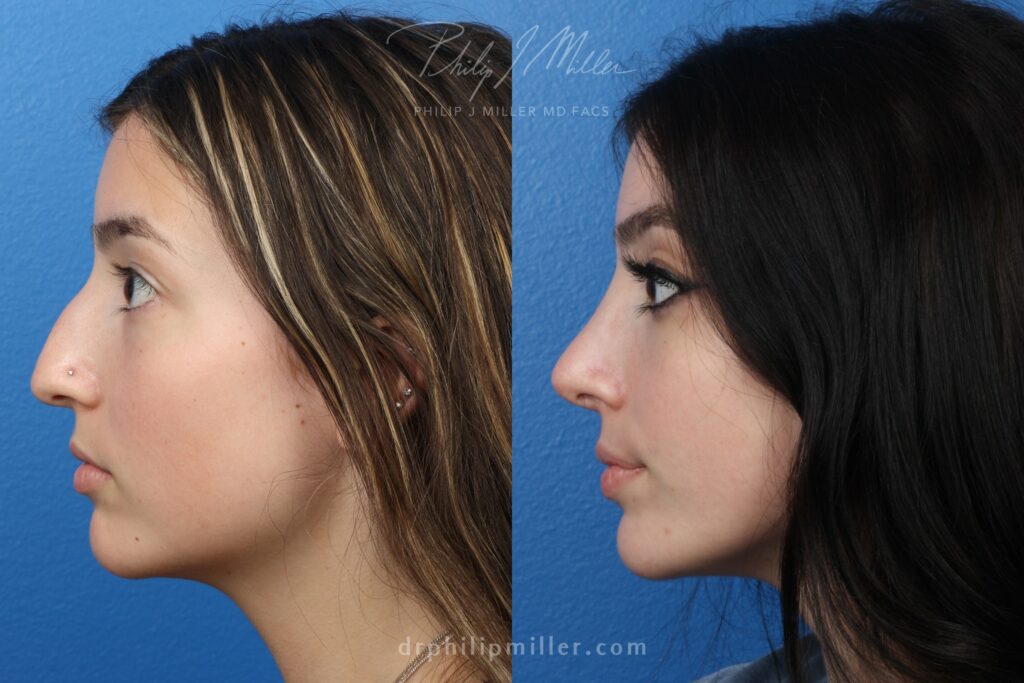
1. Zoom Boom Brings Rhinoplasty Boom
Because of the COVID-19 pandemic, 2020 was a challenging year for many businesses. But for Zoom, the video-conferencing giant, lockdown and working from home brought unprecedented growth.
Zoom usage jumped 67% between January 2020 and mid-March, when non-essential businesses and schools closed. The Zoom Boom also resulted in significant growth to an entirely different industry—cosmetic surgery.
The built-in cameras on our computers are clearly not designed to flatter the human face, and many people weren’t pleased with the reflection they saw on their computer screens.
The unflattering camera angle highlights facial flaws, such as wrinkling and sagging. People noticed unfamiliar lines, creases, and asymmetries as they saw themselves speaking on camera.
It’s not surprising that the Zoom phenomenon caused a booming demand for cosmetic procedures such as dermal injectables, laser treatments, and eye lifts.
On a Zoom conference call, the position of the computer’s camera relative to the user puts the focus on the center of the face, making the nose appear larger. As a result, demand for rhinoplasty significantly increased as well, and will likely continue into the New Year.
2. The Need for Natural
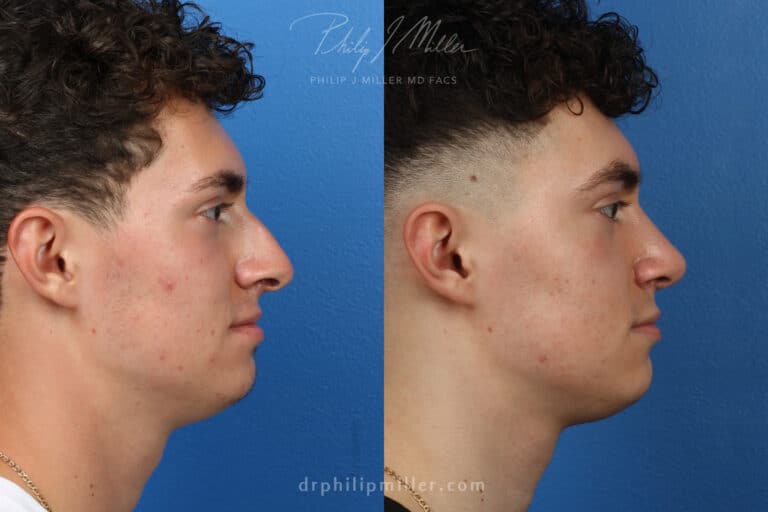
In Manhattan, Dr. Miller is renowned for the natural results he achieves for his patients, both with traditional rhinoplasty—for patients desiring more significant changes and permanent results—as well as non-surgical rhinoplasty, for patients seeking relatively minor corrections. As demands for natural results will continue to be a factor in 2022, Dr. Miller is prepared to deliver satisfying results to his New York patients.
Rhinoplasty, also known as a nose job, is a surgical procedure that can improve the appearance of the nose by reshaping, reducing, augmenting the tissue, removing a bump, or adjusting the angle between the nose and the mouth.
A major benefit of rhinoplasty is that it’s typically a “one-and-done” procedure. Once the surgery is complete and the nose has fully healed, patients can enjoy the improvements over their lifetime.
If you’re dissatisfied with your nose because of minor depressions or hollows that affect its overall appearance, non-surgical rhinoplasty may be the right solution for you. Non-surgical nose jobs are safe and effective, providing immediate results with exceptionally short recovery time. With this non-invasive procedure, injectable fillers are used to make small yet dramatic modifications to the nose.
Non-surgical rhinoplasty has its limitations, however. Since corrections are made with dermal fillers that ultimately dissolve, results aren’t permanent. Non-surgical nose jobs aren’t appropriate for every nose and can’t reduce the size of the nose.
Results will vary by patient, but the longevity of a non-surgical nose job is typically between 8-24 months. During your consultation, Dr. Miller will determine which fillers might help you achieve the best results and how long the improvement might last.
3. Faster Recovery Times
Plastic surgeons today are starting to use techniques to minimize post-procedure discomfort and healing time. Rhinoplasty is typically performed as an outpatient procedure under general anesthesia, and patients return home on the same day. While you may be up and moving within 24 hours, expect to take up to a week off from work or school as you heal.
For the first several days, you’ll need to keep your head elevated and apply ice packs to reduce swelling. Most swelling and bruising subsides within a week following rhinoplasty. Nasal dressings, splints, and sutures are removed at about seven days after surgery. At this point, any residual bruising can be effectively camouflaged with makeup. Most patients feel comfortable appearing in public at about 7-10 days post-surgery.
Swelling will continue to subside and the nose may continue to improve in definition for up to a year after surgery. However, beyond the first week, these changes are subtle and typically not noticed by others. Many patients are pleasantly surprised at how quickly they recover from rhinoplasty.
4. The Combination Approach
Achieving facial balance sometimes means making adjustments to the chin at the same time as the nose. Dr. Miller’s expertise with both procedures produces superior results.
 When rhinoplasty surgery is performed to improve the overall shape and appearance of a nose, a receding chin could diminish the aesthetic effect of the face, making it look unbalanced.
When rhinoplasty surgery is performed to improve the overall shape and appearance of a nose, a receding chin could diminish the aesthetic effect of the face, making it look unbalanced.
To achieve the best possible results with rhinoplasty, the proportions of the entire face must be considered. If your chin is well defined and proportionate to your new nose, your overall appearance will be aesthetically enhanced by rhinoplasty alone.
If you have a receding chin, however, chin augmentation surgery performed along with rhinoplasty surgery can give your face balance that rhinoplasty alone could not have achieved. Therefore, many board-certified plastic surgeons are beginning to suggest chin augmentation with rhinoplasty for certain patients.
Recovery after a chin implant takes around two weeks. You may experience swelling, tenderness, and bruising in the chin area immediately after the procedure, but most of these symptoms will diminish within about a week. Eating soft foods during the first week after surgery will help to make your recovery period more comfortable.
5. Image Morphing
The ability to “see” your results before surgery is a benefit that more patients are wanting from their rhinoplasty surgeon. At his Manhattan office, Dr. Miller uses computer imaging to help patients visualize their new nose before undergoing surgery. Besides helping communicate the goals of the patient to the surgeon before the procedure, image morphing also helps ensure patient expectations are in line with results.
If you have difficulty visualizing what your ‘after’ may look like, image morphing can help. While the final result may not be absolutely identical to the morphed picture, it provides a good idea of what you can expect.
The NatraLook Process
Aesthetic Confidence is the sense of empowerment we feel about the way we look, dress, design, and decorate. It dovetails with confidence in our abilities, intellect, and emotions. The NatraLook Process focuses exclusively on the look component of Aesthetic Confidence. The NatraLook Process is an enriching experience through which you explore and ultimately boost your aesthetic confidence by enhancing your appearance.
The NatraLook process evaluates and expands the typical plastic surgery experience into a safe, non-intimidating opportunity to explore your aesthetic confidence. It creates a unified vision of your desired result so that you and New York surgeon Dr. Philip Miller know what to expect.
Contact an Expert Plastic Surgeon to Learn More About Rhinoplasty in New York City
Whichever procedure you ultimately choose, Dr. Miller can help you achieve your goals. His approach combines art and science with skill and innovation, providing patients in Manhattan, New York, aesthetically pleasing, natural results that are always in style.
To learn more about rhinoplasty surgery and non-surgical nose jobs, contact us online or call our practice in New York. One of our patient advisers will be happy to help you.